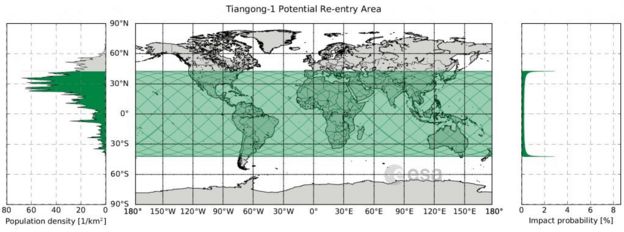Chinese space station Tiangong-1, to fall back to Earth 'in days'
Tue Mar 27, 2018 11:25:am Technology
4.7K By franklyn Anude

Scientist say debris from a defunct Chinese space station, Tiangong-1, which was put into orbit in 2011 as part of China's ambitious space programme could crash to Earth as early as Friday.
Tiangong-1 is China's prototype for a manned station in 2022 completed its mission five years after it was launched into earth's orbit.
Its reentry into earth's atmosphere is estimated to be between 30 March and 2 April. The time and place of impact is proving hard to predict as it is no longer controlled but most of the station is likely to burn up in the atmosphere.
The European Space Agency (ESA) which has provided regular updates on the Tiangong-1, predicts re-entry "will take place anywhere between 43�N and 43�S" which covers a vast stretch north and south of the equator.
The ESA expects its predictions would be more precise close to the weekend.

In 2016, China announced it had lost contact with Tiangong-1 and could therefore no longer control its direction, making predicting where it will end up difficult.
-How will it crash?-
Deputy director of the Australian Centre for Space Engineering Research, Dr Elias Aboutanios told BBC, the station's rate of descent "will continually get faster as the atmosphere that the station is ploughing through gets thicker."
He said, "The station will eventually start to heat up as it gets close to 100km [from Earth]," leading to most of it burning up, adding that "it is difficult to know exactly what will survive since the makeup of the station has not been disclosed by China".
Mr Aboutanios said if that happens during night time over a populated area it "will most certainly be visible, like a meteor or a shooting star".
Is there cause to be worried?-
Speaking at a recent press briefing, the head of the ESA's space debris office, Holger Krag, told reporters "Our experience is that for such large objects typically between 20% and 40% of the original mass will survive re-entry and then could be found on the ground, theoretically."
"However, to be injured by one of these fragments is extremely unlikely. My estimate is that the probability of being injured by one of these fragments is similar to the probability of being hit by lightning twice in the same year."
Tiangong-1 is China's prototype for a manned station in 2022 completed its mission five years after it was launched into earth's orbit.
Its reentry into earth's atmosphere is estimated to be between 30 March and 2 April. The time and place of impact is proving hard to predict as it is no longer controlled but most of the station is likely to burn up in the atmosphere.
The European Space Agency (ESA) which has provided regular updates on the Tiangong-1, predicts re-entry "will take place anywhere between 43�N and 43�S" which covers a vast stretch north and south of the equator.
The ESA expects its predictions would be more precise close to the weekend.

In 2016, China announced it had lost contact with Tiangong-1 and could therefore no longer control its direction, making predicting where it will end up difficult.
-How will it crash?-
Deputy director of the Australian Centre for Space Engineering Research, Dr Elias Aboutanios told BBC, the station's rate of descent "will continually get faster as the atmosphere that the station is ploughing through gets thicker."
He said, "The station will eventually start to heat up as it gets close to 100km [from Earth]," leading to most of it burning up, adding that "it is difficult to know exactly what will survive since the makeup of the station has not been disclosed by China".
Mr Aboutanios said if that happens during night time over a populated area it "will most certainly be visible, like a meteor or a shooting star".
Is there cause to be worried?-
Speaking at a recent press briefing, the head of the ESA's space debris office, Holger Krag, told reporters "Our experience is that for such large objects typically between 20% and 40% of the original mass will survive re-entry and then could be found on the ground, theoretically."
"However, to be injured by one of these fragments is extremely unlikely. My estimate is that the probability of being injured by one of these fragments is similar to the probability of being hit by lightning twice in the same year."
Related News
Leave a comment...





